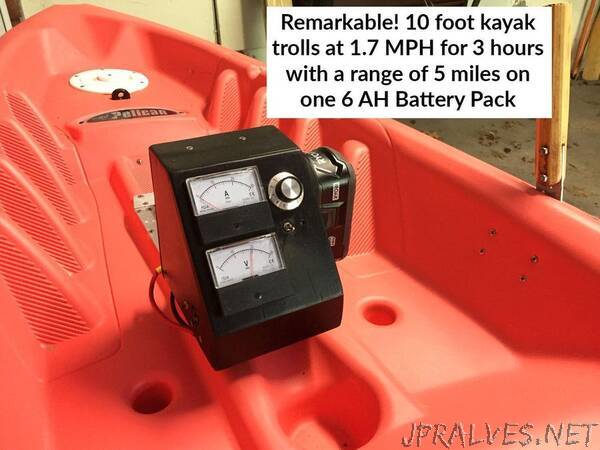
“Project uses an Arduino Uno computer and an 18 volt battery pack to efficiently power a 10 foot kayak electrically.
Project Overview
The photo above shows the console used to propel a 10 foot kayak electrically. The console contains an Arduino Uno computer capable of generating Pulse Width Modulation (PMW) signals. The Cytron driver, a 2 by 3 inch circuit board located next to the Uno, interprets the PWM signals and powers the trolling motor as it would a robot motor.
On the side of the console, a stock 4 Ampere Hour (AH) or 6 AH Ryobi Lithium battery pack (used to power cordless tools) provides the operating power for the trolling motor. The console also provides a voltmeter and an ammeter to monitor the battery charge and the power flowing to the motor. The speed of the motor is controlled by a rotary switch with 6 forward and 3 reverse speeds.
The Arduino Uno’s PWM control of the trolling motor is used in two ways, first it adjusts the 18 volt power of the Lithium-Ion battery pack to the 12 volt rating of the motor, second it controls the speed of the motor. This is where it excels: small trolling motors operate at less than full speed by inserting resistors in the battery circuit. These resistors transform the excess battery power into heat which is dissipated in the water and wasted. At low speed a typical trolling motor’s efficiency is about 25%. The PWM technique for controlling speed is 98% efficient at all speeds.
The convenience of using a battery pack to power the motor is most notable for its light weight: a 4 AH pack weighs 2 lbs. It is easy to plug into the console or into the charger which fully charges the battery in about 2 hours. Spare battery packs are easy to carry to extend the range of the cruise. The Lithium battery is also excellent at holding its charge over long periods of time and delivering its full rated power at any speed.
The components used in this project have exceptionally good value. A 10 foot kayak costs about $200, the trolling motor about $100, two 4 AH Lithium battery packs $100 and less than $100 for the miscellaneous electronics and parts needed for a handy do-it-yourselfer to put it all together.
The combination of an Arduino Uno and PWM with its simple programming has many applications. Although my interests lie mostly in boating, this type of motor control can be also be used effectively for powering go-carts or electric scooters.”
